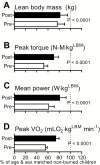Quantification of an Exercise Rehabilitation Program for Severely Burned Children: The Standard of Care at Shriners Hospitals for Children®-Galveston
- PMID: 29596648
- PMCID: PMC6060021
- DOI: 10.1093/jbcr/iry001
Quantification of an Exercise Rehabilitation Program for Severely Burned Children: The Standard of Care at Shriners Hospitals for Children®-Galveston
Abstract
Currently, there are no clear guidelines for the implementation of rehabilitative exercise training (RET) in burned individuals. Therefore, we quantified the training logs for exercise intensity, frequency, and duration of 6 weeks of this program to develop a basic framework for outpatient RET in patients recovering from severe burns. Thirty-three children (11 female, [mean ± SD] 12 ± 3 years, 145 ± 18 cm, 40 ± 11 kg, 49 ± 31 BMI percentile) with severe burns (49 ± 15% total body surface area burned, with 35 ± 22% third-degree burns) completed our 6-week resistance and aerobic exercise training program. Cardiorespiratory fitness (peak VO2), strength, power, and lean body mass (LBM) were measured before and after RET. Outcome measures were analyzed as a relative percentage of values in age- and sex-matched nonburned children (11 female, 12 ± 3 years, 154 ± 20 cm, 49 ± 22 kg, 56 ± 25 BMI percentile). At discharge, burned children had lower LBM (77% of age-sex-matched nonburn values), peak torque (53%), power (62%), and cardiorespiratory fitness (56%). After 6 weeks of training, LBM increased by 5% (82% of nonburn values), peak torque by 18% (71%), power by 20% (81%), and cardiorespiratory fitness by 18% (74%; P < .0001 for all). Quantification of data in exercise training logs suggested that physical capacity can be improved by aerobic exercise training performed at five metabolic equivalents (>70% of peak VO2) at least 3 days/week and 150 minutes/week and by resistance training performed at volume loads (reps × sets × weight) of 131 kg for the upper body and 275 kg for the lower body for 2 days/week. We present for the first time the quantification of our RET and provide clear exercise prescription guidelines specific to children with severe burn injury.
Figures






Similar articles
-
Rehabilitative Exercise Training for Burn Injury.Sports Med. 2021 Dec;51(12):2469-2482. doi: 10.1007/s40279-021-01528-4. Epub 2021 Aug 2. Sports Med. 2021. PMID: 34339042 Free PMC article. Review.
-
Children with severe burns display no sex differences in exercise capacity at hospital discharge or adaptation after exercise rehabilitation training.Burns. 2018 Aug;44(5):1187-1194. doi: 10.1016/j.burns.2018.01.014. Epub 2018 Feb 9. Burns. 2018. PMID: 29429746 Free PMC article.
-
Rehabilitation Exercise Increases Physical Activity Levels in Severely Burned Children While Improving Aerobic Exercise Capacity and Strength.J Burn Care Res. 2018 Oct 23;39(6):881-886. doi: 10.1093/jbcr/irx045. J Burn Care Res. 2018. PMID: 29596597 Free PMC article.
-
Effects of cessation of a structured and supervised exercise conditioning program on lean mass and muscle strength in severely burned children.Arch Phys Med Rehabil. 2007 Dec;88(12 Suppl 2):S24-9. doi: 10.1016/j.apmr.2007.09.002. Arch Phys Med Rehabil. 2007. PMID: 18036977 Clinical Trial.
-
Combined Aerobic and Resistance Training for Cardiorespiratory Fitness, Muscle Strength, and Walking Capacity after Stroke: A Systematic Review and Meta-Analysis.J Stroke Cerebrovasc Dis. 2020 Jan;29(1):104498. doi: 10.1016/j.jstrokecerebrovasdis.2019.104498. Epub 2019 Nov 13. J Stroke Cerebrovasc Dis. 2020. PMID: 31732460
Cited by
-
Comparison of Six-Minute Walk Test and Modified Bruce Treadmill Test in Paediatric Patients With Severe Burns: A Cross-Over Study.J Rehabil Med. 2022 Oct 19;54:jrm00305. doi: 10.2340/jrm.v54.1064. J Rehabil Med. 2022. PMID: 35801864 Free PMC article. Clinical Trial.
-
Sildenafil Recovers Burn-Induced Cardiomyopathy.Cells. 2020 Jun 3;9(6):1393. doi: 10.3390/cells9061393. Cells. 2020. PMID: 32503314 Free PMC article.
-
[Prospective study on the effects of resistance training with elastic band at home on muscle function and walking ability of severely burned children].Zhonghua Shao Shang Yu Chuang Mian Xiu Fu Za Zhi. 2023 Dec 20;39(12):1131-1139. doi: 10.3760/cma.j.cn501225-20230729-00022. Zhonghua Shao Shang Yu Chuang Mian Xiu Fu Za Zhi. 2023. PMID: 38129299 Free PMC article. Clinical Trial. Chinese.
-
Rehabilitative Exercise Training for Burn Injury.Sports Med. 2021 Dec;51(12):2469-2482. doi: 10.1007/s40279-021-01528-4. Epub 2021 Aug 2. Sports Med. 2021. PMID: 34339042 Free PMC article. Review.
-
The effect of physical exercise on cardiopulmonary fitness in burn patients: A meta-analysis.PLoS One. 2025 Aug 18;20(8):e0330301. doi: 10.1371/journal.pone.0330301. eCollection 2025. PLoS One. 2025. PMID: 40825040 Free PMC article.
References
-
- World Health Organization. The global burden of disease: 2004 update. Geneva, Switzerland: 2008.
-
- Shields BJ, Comstock RD, Fernandez SA, Xiang H, Smith GA. Healthcare resource utilization and epidemiology of pediatric burn-associated hospitalizations, United States, 2000. J Burn Care Res 2007;28:811–826. - PubMed
-
- Gibran NS, Wiechman S, Meyer W, et al. . Summary of the 2012 ABA burn quality consensus conference. J Burn Care Res 2013;34:361–385. - PubMed
Publication types
MeSH terms
Grants and funding
LinkOut - more resources
Full Text Sources
Other Literature Sources
Medical

